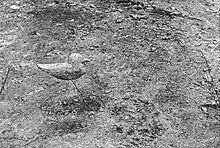Countershading
Countershading, or Thayer's Law, is a form of camouflage. Countershading, in which an animal’s pigmentation is darker dorsally, is often thought to have an adaptive effect of reducing conspicuous shadows cast on the ventral region of an animal’s body. In essence the distribution of light on objects that are lit from above will cause unequal reflection of light on a solid body of uniform colour; such shadows could provide predators with visual cues to a prey's shape and projection. Countershading therefore reduces the ease of detection of prey by potential predators by counterbalancing the effects of shadowing.
Examples
Countershading is observed in a large variety of animals, such as pronghorn antelope, White-tailed deer, squirrels, birds, and various lepidopteran larvae.
Alternatively, in many marine animals (including various species of fish such as marlins and sharks, penguins and cephalopods) this form of camouflage may work through background matching; when seen from the top, the darker dorsal area of the animal blends into the darkness of the water below, and when seen from below, the lighter ventral area blends into the sunlight from the surface.
Furthermore, countershading could also result from differential selection pressures on dorsal and ventral surfaces, from the need to protect against the damaging properties of UV light or abrasion.
History


Abbott Handerson Thayer was one of the first to conduct extensive research on and to write about certain aspects of protective colouration in nature. In 1892, he wrote about the function of countershading in nature, in which he accounted for the white undersides of animals. For this reason countershading is sometimes called Thayer’s Law.
Military camouflage sometimes uses the same principle; Thayer even obtained a patent in 1902 to paint warships using a countershaded scheme.
Gallery
-
Anolis caroliensis showing blending camouflage and countershading
-
Countershading in caterpillars
-
Countershading in Eyed hawk moth
-
Salmon
-
Adelie penguins
-
Ringtailed lemur
See also
- Synodontis nigriventris, an "upside-down" catfish (with reverse countershading)
- counterchanging, a heraldic device of similar appearance
References
- Edmunds, M. & R.A. Dewhirst (1994). The survival value of countershading with wild birds as predators. Biological Journal of the Linnean Society 51(4): 447-452.
- Ruxton, G.D., M.P. Speed & D.J. Kelly (2004). What, if anything, is the adaptive function of countershading? Animal Behaviour 68(3): 445-451.
- Speed, M.P., D.J. Kelly, A.M. Davidson, G.D. Ruxton(2005). Countershading enhances crypsis with some bird species but not others. Behavioral Ecology 16(2): 327-334.
- ^ Behrens, Roy (27 February 2009). "Revisiting Abbott Thayer: non-scientific reflections about camouflage in art, war and zoology". Philosophical Transactions of the Royal Society B - Biology. 364 (1516). Royal Society Publishing: 497–501. doi:10.1098/rstb.2008.0250. PMC 2674083. PMID 19000975. Retrieved 2009-05-05.




